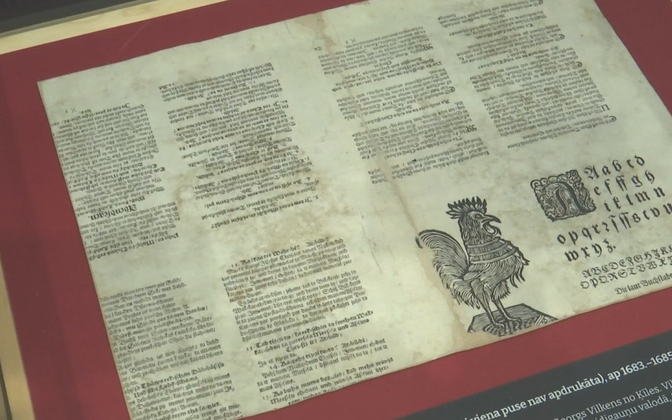An exhibition at Latvia’s National Library in Riga focuses on the shared history of language primer books in both Estonia and Latvia.
The exhibition marks the 500th anniversary of these first printed primers (Estonian: Aabits, ie. ‘ABC’). An example donated by Estonia to Latvia for the exhibition, and actually printed in Riga, dates to the 17th century.
These primers prominently featured a rooster, and the Latvian capital hosted two days of grand celebrations for the 500th anniversary of such books. The rooster motif, found in both Estonian and Latvian primers, has long symbolized learning from this early period down to modern times.
Five centuries ago, much of modern-day Estonia and Latvia formed the territory of Livonia, itself separated into various bishoprics and archbishoprics. At that time, the cultural and religious landscape of the region was rapidly changing, and the arrival of both the printing press, invented in the 15th century by Johannes Gutenberg, and the magisterial reformation in the region meant literacy and religious catechism often went hand in hand, as did the German, Estonian and Latvian languages.
The origins of the rooster motif on show were the reliquary at the Castle Church in Wittenberg, famously the location where Martin Luther nailed his 95 theses to the church door. It was printed on a single sheet of paper which could then be folded into a 16-page book.
The oldest primers were also in effect religious textbooks, as in addition to letters and syllables they contained a brief summary of the Lutheran small catechism.
 The rooster continued to appear on primers in both Latvian and Estonian, down to modern times. Source: ERR
The rooster continued to appear on primers in both Latvian and Estonian, down to modern times. Source: ERR
The oldest Estonian primers were printed in Riga at the same printing house as the oldest Latvian primers, and the rooster, or cockerel, remained a common motif in many Estonian and Latvian primers down to modern times.
The Tartu primer, so-called because it has been housed there, was likely printed in Riga in the late 17th century, by which time Livonia, by this time consisting of much of the southern half of Estonia and roughly the northern third of Latvia, was under Swedish rule, a state of affairs later to end after the Great Northern War.
“The primer was probably printed in the early 1680s at the Royal printing house in Riga. But that printing was not completed – printing appears on one side only, so that primer became scrap paper. This scrap paper ended up in the reopened University of Tartu, while in 1691, after the university was reopened, it was bound together as an accounts book. And the cover page of this accounts book was this primer,” explained Aivar Põldvee, researcher at Tallinn University and curator of the exhibition.
The primer has been handed to Latvia as a symbolic gift from Estonia, which has just had its year of the book, marking a similar anniversary.
The exhibition at the Latvian National Library in Riga is also hosting a working replica of a Gutenberg-era printing press that resembles a fruit press. Alongside this historical reconstruction, the director of Latvia’s central bank also introduced a commemorative coin created for the 500th anniversary.
A lack of interest in reading, especially among children, is seen as an issue in both countries. While Latvians have a national action plan to solve the issue, so too do Estonians.
“A major reading survey in Estonia led by [academic and former politician] Marju Lauristin is about to be completed, which will provide answers to many questions,” Martin Öövel, Director General of the Estonian National Library, said.
—
Editor:
Andrew Whyte, Marko Tooming.
Source:
‘Aktuaalne kaamera,’ reporter Ragnar Kond.
